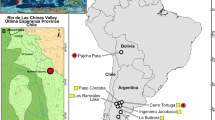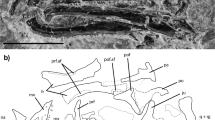Abstract
Middle Pliocene hominin species diversity has been a subject of debate over the past two decades, particularly after the naming of Australopithecus bahrelghazali and Kenyanthropus platyops in addition to the well-known species Australopithecus afarensis. Further analyses continue to support the proposal that several hominin species co-existed during this time period. Here we recognize a new hominin species (Australopithecus deyiremeda sp. nov.) from 3.3–3.5-million-year-old deposits in the Woranso–Mille study area, central Afar, Ethiopia. The new species from Woranso–Mille shows that there were at least two contemporaneous hominin species living in the Afar region of Ethiopia between 3.3 and 3.5 million years ago, and further confirms early hominin taxonomic diversity in eastern Africa during the Middle Pliocene epoch. The morphology of Au. deyiremeda also reinforces concerns related to dentognathic (that is, jaws and teeth) homoplasy in Plio–Pleistocene hominins, and shows that some dentognathic features traditionally associated with Paranthropus and Homo appeared in the fossil record earlier than previously thought.
This is a preview of subscription content, access via your institution
Access options
Subscribe to this journal
Receive 51 print issues and online access
$199.00 per year
only $3.90 per issue
Buy this article
- Purchase on Springer Link
- Instant access to full article PDF
Prices may be subject to local taxes which are calculated during checkout






Similar content being viewed by others
References
Haile-Selassie, Y. et al. A new hominin foot from Ethiopia shows multiple Pliocene bipedal adaptations. Nature 483, 565–570 (2012).
Brunet, M. et al. Australopithecus bahrelghazali, une nouvelle espèce d'Hominidé ancien de la région de Koro Toro (Tchad). C. R. Acad. Sci. 322, 907–913 (1996).
Leakey, M. G. et al. New hominin genus from eastern Africa shows diverse middle Pliocene lineages. Nature 410, 433–440 (2001).
Spoor, F., Leakey, M. G. & Leakey, L. N. Hominin diversity in the middle Pliocene of eastern Africa: the maxilla of KNM-WT 4000. Phil. Trans. R. Soc. B 365, 3377–3388 (2010).
Guy, F. et al. Symphyseal shape variation in extant and fossil hominoids, and the symphysis of Australopithecus bahrelghazali. J. Hum. Evol. 55, 37–47 (2008).
White, T. Early hominids – diversity or distortion? Science 299, 1994–1997 (2003).
Lovejoy, C. O., Latimer, B., Suwa, G., Asfaw, B. & White, T. D. Combining prehension and propulsion: the foot of Ardipithecus ramidus. Science 326, 72e1–72e8 (2009).
Kimbel, W. H., Johanson, D. C. & Rak, Y. Systematic assessment of a maxilla of Homo from Hadar, Ethiopia. Am. J. Phys. Anthropol. 103, 235–262 (1997).
Kimbel, W. H., Rak, Y. & Johanson, D. C. The Skull of Australopithecus afarensis (Oxford Univ. Press, 2004).
Johanson, D. C., White, T. D. & Coppens, Y. Dental remains from the Hadar Formation, Ethiopia: 1974–1977 collections. Am. J. Phys. Anthropol. 57, 545–603 (1982).
Ward, C. V., Leakey, M. G. & Walker, A. Morphology of Australopithecus anamensis from Kanapoi and Allia Bay, Kenya. J. Hum. Evol. 41, 255–368 (2001).
Manthi, F., Plavcan, M. & Ward, C. New hominin fossils from Kanapoi, Kenya: mosaic evolution of canine evolution in early hominins. So. Afr. J. Sci. 108, 1–9 (2012).
Ward, C. V., Manthi, F. K. & Plavcan, J. M. New fossils of Australopithecus anamensis from Kanapoi, West Turkana, Kenya (2003–2008). J. Hum. Evol. 65, 501–524 (2013).
Suwa, G. et al. The first skull of Australopithecus boisei. Nature 389, 489–492 (1997).
Kimbel, W. H. & Delezene, L. K. ‘Lucy’ redux: a review of research on Australopithecus afarensis. Am. J. Phys. Anthropol. 49, 2–48 (2009).
Brown, B., Brown, F. H. & Walker, A. New hominids from the Lake Turkana Basin, Kenya. J. Hum. Evol. 41, 29–44 (2001).
White, T. D. & Johanson, D. C. Pliocene hominid mandibles from the Hadar Formation. Ethiopia: 1974–1977 collections. Am. J. Phys. Anthropol. 57, 501–544 (1982).
Johanson, D. C., White, T. & Coppens, Y. A New Species of the Genus Australopithecus (Primates: Hominidae) From the Pliocene of Eastern Africa (Kirtlandia) (Cleveland Museum of Natural History, 1978).
White, T. D., Suwa, G., Simpson, S. W. & Asfaw, B. Jaws and teeth of Australopithecus afarensis from Maka. Middle Awash, Ethiopia. Am. J. Phys. Anthropol. 111, 45–68 (2000).
Wood, B. & Richmond, B. Human evolution: taxonomy and paleobiology. J. Anat. 197, 19–60 (2000).
Villmoare, B. et al. Early Homo at 2.8 Ma from Ledi-Geraru, Afar, Ethiopia. Science 347, 1352–1355 (2015).
Asfaw, B. et al. Australopithecus garhi: a new species of early hominid from Ethiopia. Science 284, 629–635 (1999).
Leakey, M. G., Feibel, C. S., McDougall, I. & Walker, A. New four-million-year-old hominid species from Kanapoi and Allia Bay, Kenya. Nature 376, 565–571 (1995).
Spoor, F. et al. Reconstructed Homo habilis type OH 7 suggests deep-rooted species diversity in early Homo. Nature 519, 83–86 (2015).
Wood, B. Koobi Fora Research Project Vol. 4 (Clarendon, 1991).
White, T. D., Johanson, D. C. & Kimbel, W. H. in New Interpretations of Ape and Human Ancestry (eds Ciochon, R. L. & Corruccini, R. S. ) 721–780 (Plenum, 1983).
Harrison, T. in Paleontology and Geology of Laetoli: Human Evolution in Context (ed. Harrison, T. ) Vol. 2 141–188 (Dordrecht: Springer, 2011).
White, T. D. Additional fossil hominids from Laetoli, Tanzania: 1976–1979 specimens. Am. J. Phys. Anthropol. 53, 487–504 (1980).
White, T. D. New fossil hominids from Laetolil, Tanzania. Am. J. Phys. Anthropol. 46, 197–229 (1977).
White, T. D. et al. Asa Issie, Aramis and the origin of Australopithecus. Nature 440, 883–889 (2006).
White, T. D., Suwa, G., Simpson, S. W. & Asfaw, B. Jaws and teeth of Australopithecus afarensis from Maka. Middle Awash, Ethiopia. Am. J. Phys. Anthropol. 111, 45–68 (2000).
Suwa, G. et al. Paleobiological implications of the Ardipithecus ramidus dentition. Science 326, 94–99 (2009).
Leakey, M. G. et al. New fossils from Koobi Fora in northern Kenya confirm taxonomic diversity in early Homo. Nature 488, 201–204 (2012).
Olejniczak, A. J. et al. Three-dimensional molar enamel distribution and thickness in Australopithecus and Paranthropus. Biol. Lett. 4, 406–410 (2008).
Acknowledgements
We thank the Authority for Research and Conservation of Cultural Heritage and the Afar Regional State of Ethiopia for permission to conduct field and laboratory research, the Afar people of the Woranso–Mille area for their hospitality, and the project’s fieldwork crew members for their incredible contributions in our fieldwork endeavours. We would also like to thank S. W. Simpson and W. H. Kimbel for their constructive comments and discussions throughout the preparation of this manuscript; G. Suwa, T. White and B. Asfaw for access to the original Ardipithecus ramidus material; W. H. Kimbel for access to the original Australopithecus afarensis material; F. Spoor for discussion of Kenyanthropus platyops morphology and Lomekwi mandibular metrics; D. F. Su for comments and assistance with the figures. This research was financially supported by grants from the LSB Leakey Foundation, the National Geographic Society, the Cleveland Museum of Natural History, and the National Science Foundation (BCS-0234320, BCS-0321893, BCS-0542037, BCS-1124705, BCS-1124713, BCS-1124716, BCS-1125157 and BCS-1125345).
Author information
Authors and Affiliations
Contributions
Y.H.-S. directed the field research. A.D., B.Z.S., M.A., L.G. and S.M.M. participated in the field research. T.M.R. conducted the computed tomography scanning and made the virtual reconstructions. A.D., B.Z.S., L.G. and M.A. studied the geological context, while L.G. and G.S. conducted the palaeomagnetic analysis. S.M.M. conducted the phylogenetic analysis. Y.H.-S. and S.M.M. made comparative observations and carried out analyses. Y.H.-S. took the lead in writing the paper with contributions from all coauthors.
Corresponding author
Ethics declarations
Competing interests
The authors declare no competing financial interests.
Additional information
The LSID urn:lsid:zoobank.org:pub:0C492889-01AC-4CDD-96FD-0E08A51F3CBB has been deposited in ZooBank.
Extended data figures and tables
Extended Data Figure 1 Computed-tomography-based visualization of BRT-VP-3/1.
a, Lateral view. b, Medial view. c, Anterior view. d, Palatal view. e, Superior view. f, Palatal view mirror-imaged on midline. g, Superior view mirror-imaged on midline. Computed-tomography-based cross-sections of BRT-VP-3/1. h, Sagittal cross-section along the centre of the dental row showing root morphology. i, Sagittal cross-section at I1. j, Transverse cross-section along the roots showing the number of roots of each tooth. k, Sagittal cross-section at I2. l, Midsagittal cross-section showing the shape of the palatine process and nasoalveolar clivus. m, Transverse cross-section across the incisors and the canine.
Extended Data Figure 2 Computed-tomography-based visualization of BRT-VP-3/14.
a, Right lateral view. b, Left lateral view. c, Sagittal cross-section along the centre of the right dental row showing root morphology. d, Sagittal cross-section along the centre of the left dental row showing root morphology. e, Occlusal view. f, Transverse cross-section along the roots showing the number of roots of each tooth. Note that the premolars have several roots. g, Basal view. h, Symphyseal cross-section. Computed-tomography-based visualization of WYT-VP-2/10. i, Right lateral view. j, Medial view. k, Occlusal view. l, Basal view. m, Sagittal cross-section along the centre of the dental row showing root morphology. n, Symphyseal cross-section. o, Transverse cross-section along the roots showing the number of roots of each tooth.
Extended Data Figure 3 Magnetostratigraphy.
a, Magnetostratigraphy for the Burtele area, measured in five subsections beginning with the oldest strata in the southwest (BRT-VP-3), to the youngest at BRT-VP-2 (see Fig. 2 for sub-sections locations). This stratigraphy consists predominantly of claystones/siltstones alternating with sandstones, and includes a 20-cm carbonate bed, a 2–6-m basalt flow, and a 5-cm tuff bed. The sandstones occupy slightly sinuous fluvial channels with a low width/depth ratio in a weakly confined setting. The sandstone beds are continuous and interestratified with pedogenically modified fine-grained overbank and ephemeral lake deposits. The proportion of sandstones increases upwards in the section, where it is accompanied by the occurrence of celestine nodules indicating increased aridity. Sixteen palaeomagnetic samples were obtained from fine-grained lithologies. All samples demonstrate normal polarity (black bars), interpreted as belonging to a single polarity chron C2An.3n (3.596–3.330 Myr old) of the Astronomically Tuned Neogene Time Scale (ATNTS2004). b, Orthogonal demagnetization diagrams showing vector endpoints after alternating field and thermal demagnetization for samples MB13.1Aa and FS12.2b. Horizontal projections are shown as squares, vertical projection as diamonds, and NRM (4 mT) starting point as star. c, Palaeomagnetic directions for the Burtele stratigraphy from samples collected a long different stratigraphic horizons. Stereographic projection referenced to magnetic North (declination 2° E), with solid symbols on lower hemisphere (plus inclination). Represented directions are the mean directions for each sample from three specimens. The start shows the location of the expected normal direction for this latitude (000/22).
Extended Data Figure 4 Comparisons of midsagittal cross section of the hard palate and nasoalveolar clivus.
a, BRT-VP-3/1. b, A.L. 444-2. c, A.L. 200-1. d, A.L. 486-1. e, A.L. 427-1. f, A.L. 199-1. g. A.L. 442-1. Note that the overlap between the hard palate and the nasolalveolar clivus of BRT-VP-3/1 is small relative to most Au. afarensis specimens. Midsagittal cross-sections of Au. afarensis maxillae were modified from Fig. 5.22 in ref. 9.
Extended Data Figure 5 BRT-VP-3/1 (reversed) and BRT-VP-3/14 shown in occlusion.
The upper canine is aligned mesial to the P3. Despite the apparently large size of the mandible (BRT-VP-3/14), the maxilla (BRT-VP-3/1) is only slightly smaller. The position of the second molars is indicated to show that the canine-to-second-molar length is comparable in both specimens.
Supplementary information
Supplementary Information
This file contains Supplementary Notes 1-8 and Supplementary References. (PDF 807 kb)
Rights and permissions
About this article
Cite this article
Haile-Selassie, Y., Gibert, L., Melillo, S. et al. New species from Ethiopia further expands Middle Pliocene hominin diversity. Nature 521, 483–488 (2015). https://doi.org/10.1038/nature14448
Received:
Accepted:
Published:
Issue Date:
DOI: https://doi.org/10.1038/nature14448
This article is cited by
-
Dental morphology in Homo habilis and its implications for the evolution of early Homo
Nature Communications (2024)
-
Reappraising the palaeobiology of Australopithecus
Nature (2023)
-
The effects of mid-to-late Pliocene climatic fluctuations on the habitat and distribution of early hominins
Human Ecology (2023)
-
Investigating Isotopic Niche Space: Using rKIN for Stable Isotope Studies in Archaeology
Journal of Archaeological Method and Theory (2022)
Comments
By submitting a comment you agree to abide by our Terms and Community Guidelines. If you find something abusive or that does not comply with our terms or guidelines please flag it as inappropriate.



